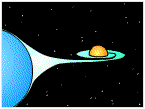Binary Star Systems
Created | Updated Jun 13, 2014

Binary star systems consist of two stars orbiting a common centre of mass. Multiple star systems such as binaries may make up the majority of stars we see in the sky. There are several different classifications of Binary Star systems. Although there are no intrinsic differences between the stars in one type of system or another, the methods of observation used to determine that a system is a binary is different in each case.
A binary, or double, star known in the Arabic world was zeta Ursae Majoris, known to them as Mizar and Alcor, the horse and rider. They used this binary as a sight test; if your sight was good you would be able to see that there were two stars there, if it was bad then you would be unable to.
Different Types of Binary Star Systems
Visual Binaries
Visual binaries are systems which can be resolved1 with a telescope. There are different types of visual binary:
Physical Binaries are where the two stars are actually orbiting one another.
Optical Binaries are where the stars appear very close together in the sky, while they are in fact very far apart and not gravitationally bound.
Spectroscopic Binaries
When viewing these stars with a telescope, they cannot be viewed separately; they appear to be a single star. However, when viewing the absorption lines in their spectra, a regular oscillation is observed. This is because the two stars do not have identical spectra, so when one is closer the overall spectrum is seen to change.
Eclipsing Binaries
The plane of the orbit of the stars in an eclipsing binary system is perpendicular to the sky; we view these systems edge on. When one star passes in front of the other, the overall magnitude of the system decreases.
For example, suppose you had one very bright star and one quite dim star. When they appear next to each other, the magnitudes of both of the stars combine to produce the magnitude of the system. When the dim star eclipses the bright star, there is a big drop in magnitude because you can no longer see the brighter star. When the bright star eclipses the dim star, there is a smaller drop in magnitude for the whole system because the dim star's light is obscured. The magnitude of the system plotted against time would show two drops during a complete cycle, one bigger than the other.
Binary star systems are important to astronomers to determine the mass of individual stars. Because it is possible to determine the speed at which they orbit and the distance they are from each other, it is possible to infer their masses using Newtonian Mechanics. It is not possible to do this for a single star, as there is not enough information available just by looking at it.
One of the most attractive looking binary stars is Albireo in the constellation Cygnus, also known as The Swan, which is blue and gold.

